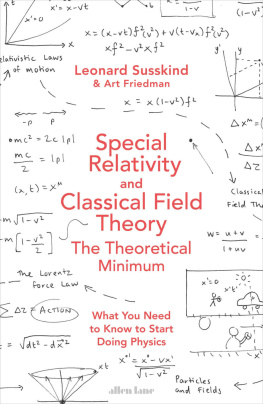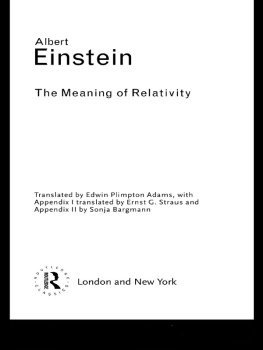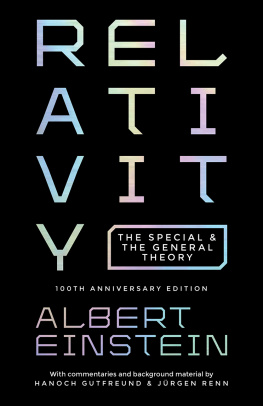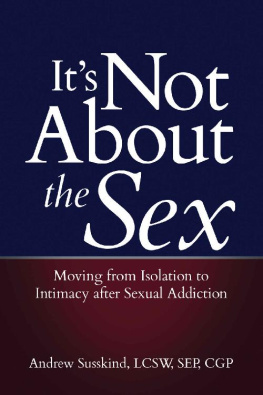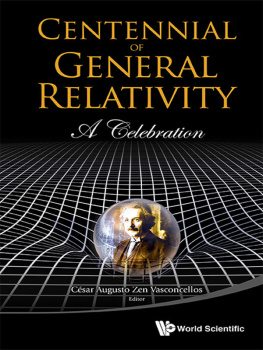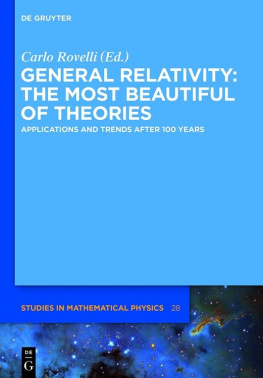Leonard Susskind - General Relativity: The Theoretical Minimum
Here you can read online Leonard Susskind - General Relativity: The Theoretical Minimum full text of the book (entire story) in english for free. Download pdf and epub, get meaning, cover and reviews about this ebook. year: 2022, publisher: Basic Books, genre: Children. Description of the work, (preface) as well as reviews are available. Best literature library LitArk.com created for fans of good reading and offers a wide selection of genres:
Romance novel
Science fiction
Adventure
Detective
Science
History
Home and family
Prose
Art
Politics
Computer
Non-fiction
Religion
Business
Children
Humor
Choose a favorite category and find really read worthwhile books. Enjoy immersion in the world of imagination, feel the emotions of the characters or learn something new for yourself, make an fascinating discovery.

- Book:General Relativity: The Theoretical Minimum
- Author:
- Publisher:Basic Books
- Genre:
- Year:2022
- Rating:3 / 5
- Favourites:Add to favourites
- Your mark:
- 60
- 1
- 2
- 3
- 4
- 5
General Relativity: The Theoretical Minimum: summary, description and annotation
We offer to read an annotation, description, summary or preface (depends on what the author of the book "General Relativity: The Theoretical Minimum" wrote himself). If you haven't found the necessary information about the book — write in the comments, we will try to find it.
General Relativity: The Theoretical Minimum — read online for free the complete book (whole text) full work
Below is the text of the book, divided by pages. System saving the place of the last page read, allows you to conveniently read the book "General Relativity: The Theoretical Minimum" online for free, without having to search again every time where you left off. Put a bookmark, and you can go to the page where you finished reading at any time.
Font size:
Interval:
Bookmark:
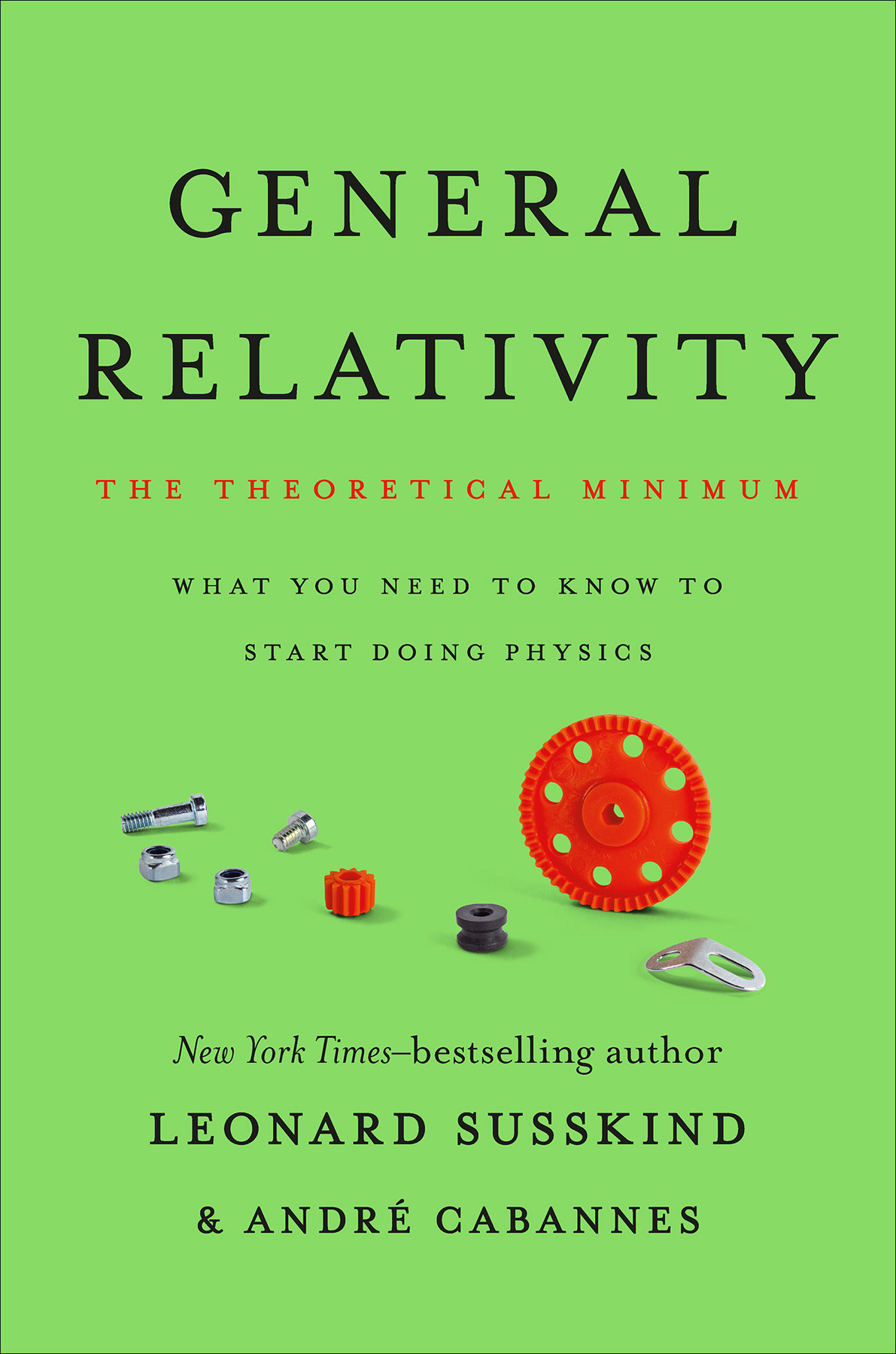

This book is the fourth volume of The Theoretical Minimum series. The first volume, The Theoretical Minimum: What You Need to Know to Start Doing Physics, covered classical mechanics, which is the core of any physics education. We will refer to it from time to time simply as volume 1. The second book, volume 2, explains quantum mechanics and its relationship to classical mechanics. Volume 3 covers special relativity and classical field theory. This fourth volume expands on that to explore general relativity.
Also by Leonard Susskind
Special Relativity and Classical Field Theory: The Theoretical Minimum
Quantum Mechanics: The Theoretical Minimum
The Theoretical Minimum: What You Need to Know to Start Doing Physics
The Black Hole War: My Battle with Stephen Hawking to Make the World Safe for Quantum Mechanics
The Cosmic Landscape: String Theory and the Illusion of Intelligent Design
An Introduction to Black Holes, Information and the String Theory Revolution: The Holographic Universe
This fourth volume in The Theoretical Minimum (TTM) series on general relativity is the natural continuation of the third volume on special relativity.
In special relativity, Einstein, starting from a very simple principle the laws of physics should be the same in indistinguishable Galilean referentials deeply clarified in a couple of papers published in 1905 the various disturbing observations physicists had made and the equations they had written in the last years of the nineteenth and the first years of the twentieth century concerning light and other phenomena.
Special relativity led to a strange description of space-time where time and space were inextricably mingled. For instance, it explained how particles whose lifetime is measured in fractions of a second can have, in our referential, a travel time from the Sun to Earth of more than eight minutes.
Then, from 1907 until 1915, essentially alone, Einstein reproduced his feat starting now from another very simple principle acceleration and uniform gravity are equivalent. He generalized special relativity to a space-time containing massive bodies. The theory is called general relativity (GR). It led to an even stranger description of space-time where masses bend light and more generally warp space and time.
In , we prepare the groundwork. We show how the equivalence principle inescapably leads to the bending of light rays by massive bodies.
is devoted to tensor mathematics because in GR we must frequently change referentials and the equations relating coordinates in one referential to coordinates in another are tensor equations.
Then a large part of the theory is expressed using tensor equations because they have the great quality that if they hold in one referential, they hold in all of them.
are devoted to the geometry of Riemannian space and Minkowskian space-time because it can be said, very summarily, that gravity is geometry in a Minkowskian space-time.
In , we explore black holes, not so much because they are interesting astronomical phenomena per se, than because they are the equivalent in Minkowskian space-time of point masses in Newtonian mechanics. Space-time however presents a stranger behavior in the vicinity of a black hole than Newtonian space in the vicinity of a point mass. Understanding well black holes, the metric they create, their horizon, time and gravity in the vicinity of their horizon, the way people in and out of a black hole can communicate, etc. is a prerequisite to understanding GR.
In we present a simple application predicting gravity waves.
This book, as the preceding ones in the series, is adapted from a course I gave for several years, with much pleasure, at Stanford in the Continuing Studies program to an audience of adults.
My coauthor this time is Andr Cabannes. Even though he is not a professional scientist, his scientific training, including a Stanford doctorate and a couple of years of teaching applied mathematics at the Massachusetts Institute of Technology (MIT), helped him assist me.
May Einsteins way of doing physics starting from the simplest principles and pursuing dauntlessly the mathematics and the physics to their ultimate consequences, however unsettling they may be as I have strived to show in this book, be a source of inspiration to young and future physicists.
Leonard Susskind
Palo Alto, California
Fall 2022
Ten years ago, when two of my children, then in their late teens, were studying sciences to enter the French system of grandes coles, I decided to brush up what I had learned in the seventies in order to accompany them in their studies. I discovered that the Internet had profoundly changed the learning landscape. Beside reading books, one could now also take excellent free courses on the Net. I leisurely attended courses in mathematics, physics, computer science, etc. from MIT, Stanford, and other places. The subject matters often were better explained, the courses more lively and easier to understand, than what I had experienced in the past. One could choose courses by the worlds best teachers.
Among these courses was The Theoretical Minimum series by Leonard Susskind, famous among other reasons for his pioneering work on string theory. I liked them so much that when I discovered that two of his filmed physics courses had already been transformed into books, I decided to translate them in French. Later I also translated the third book. Then, since the next volume didnt exist in English yet, I took up writing the English notes as well, having in mind that this work might turn out to be useful. After a lot more work with Professor Susskind and Basic Books team, volume 4 in The Theoretical Minimum series, on general relativity, that you hold in your hands is the result.
I belong to the group of people to whom these so-called Continuing Studies courses were intended: individuals who studied physics at the undergraduate and sometimes graduate level when they were students, then did other things in life, but kept an interest in sciences and would like to have some exposure to where physics stands today at a level above plain vulgarization. Indeed, personally, I have always found vulgarization more confusing and harder to understand than real explanations with some equations.
Leonards courses gave me access to Lagrangian classical mechanics, quantum mechanics, and classical field theory with a clarity that I had never known before. With his pedagogy and presentation it becomes a pleasure to learn. Of course, it is all the more true when there is no examination of any sort at the end. But the courses and books turned out to be useful for students as well, to prepare for more advanced and academic studies.
So whether you are someone who only wants to have some real understanding of what general relativity is about the stuff on gravitation that is geometry, masses that bend space, light, and time, black holes out there that you should avoid falling into, gravity waves that we begin to detect, etc. or you are a student in physics who wants to have a first presentation of general relativity, this book is for you.
Andr Cabannes
Saint-Cyr-sur-mer,
French Riviera
Fall 2022
To my family
LS
Font size:
Interval:
Bookmark:
Similar books «General Relativity: The Theoretical Minimum»
Look at similar books to General Relativity: The Theoretical Minimum. We have selected literature similar in name and meaning in the hope of providing readers with more options to find new, interesting, not yet read works.
Discussion, reviews of the book General Relativity: The Theoretical Minimum and just readers' own opinions. Leave your comments, write what you think about the work, its meaning or the main characters. Specify what exactly you liked and what you didn't like, and why you think so.

